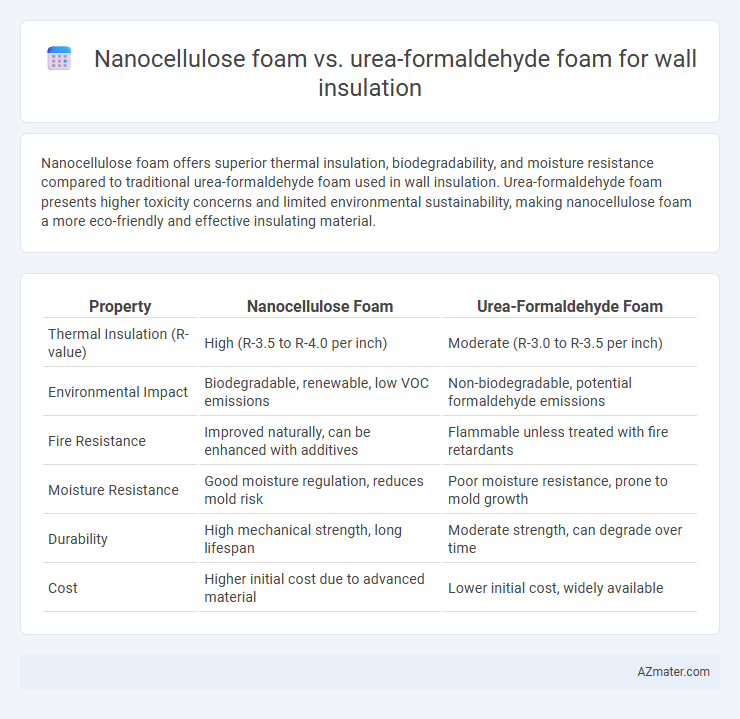Nanocellulose foam offers superior thermal insulation, biodegradability, and moisture resistance compared to traditional urea-formaldehyde foam used in wall insulation. Urea-formaldehyde foam presents higher toxicity concerns and limited environmental sustainability, making nanocellulose foam a more eco-friendly and effective insulating material.
Table of Comparison
| Property | Nanocellulose Foam | Urea-Formaldehyde Foam |
|---|---|---|
| Thermal Insulation (R-value) | High (R-3.5 to R-4.0 per inch) | Moderate (R-3.0 to R-3.5 per inch) |
| Environmental Impact | Biodegradable, renewable, low VOC emissions | Non-biodegradable, potential formaldehyde emissions |
| Fire Resistance | Improved naturally, can be enhanced with additives | Flammable unless treated with fire retardants |
| Moisture Resistance | Good moisture regulation, reduces mold risk | Poor moisture resistance, prone to mold growth |
| Durability | High mechanical strength, long lifespan | Moderate strength, can degrade over time |
| Cost | Higher initial cost due to advanced material | Lower initial cost, widely available |
Introduction to Wall Insulation Materials
Nanocellulose foam offers a sustainable and biodegradable alternative to traditional wall insulation materials like urea-formaldehyde foam, which is widely used but often criticized for potential formaldehyde emissions. Nanocellulose foam provides excellent thermal insulation with high porosity and low density, enhancing energy efficiency while minimizing environmental impact. Urea-formaldehyde foam remains effective for soundproofing and moisture resistance but faces increasing regulatory scrutiny due to health concerns linked to its chemical composition.
Overview of Nanocellulose Foam
Nanocellulose foam is derived from plant-based cellulose fibers, exhibiting exceptional thermal insulation properties with a low thermal conductivity typically around 0.03 W/m*K. Its biodegradability and renewable sourcing make it an eco-friendly alternative to conventional urea-formaldehyde foam, which contains formaldehyde, a volatile organic compound linked to indoor air quality issues. Nanocellulose foam also offers superior mechanical strength and moisture resistance, enhancing durability and reducing the risk of mold growth in wall insulation applications.
Understanding Urea-Formaldehyde Foam
Urea-formaldehyde foam is a synthetic insulation material commonly used in wall construction, recognized for its ease of application and high thermal resistance properties. It is created through the chemical reaction of urea and formaldehyde, forming a rigid cellular structure that traps air, thus reducing heat transfer. Concerns regarding emission of formaldehyde gas have led to increased scrutiny, emphasizing the importance of proper ventilation and advanced formulations to minimize indoor air quality impact.
Thermal Insulation Performance Comparison
Nanocellulose foam offers superior thermal insulation with a thermal conductivity ranging from 0.030 to 0.035 W/m*K, compared to urea-formaldehyde foam's typical range of 0.040 to 0.050 W/m*K, resulting in enhanced energy efficiency for building walls. The nanocellulose structure provides better air entrapment and moisture resistance, reducing thermal bridging and heat loss. Urea-formaldehyde foam, while cost-effective, tends to degrade faster under humidity, compromising its long-term insulation performance.
Environmental Impact and Sustainability
Nanocellulose foam offers significant environmental benefits over urea-formaldehyde foam due to its renewable origin from plant fibers and biodegradability, minimizing long-term waste and pollution. Urea-formaldehyde foam, derived from petrochemicals, releases formaldehyde gas, a known carcinogen, raising health and environmental concerns during installation and disposal. The sustainable production and non-toxic nature of nanocellulose foam contribute to lower carbon footprints and enhanced indoor air quality, making it a more eco-friendly choice for wall insulation.
Health and Safety Concerns
Nanocellulose foam offers a non-toxic, biodegradable alternative to traditional urea-formaldehyde foam, which is known for off-gassing formaldehyde, a recognized carcinogen linked to respiratory issues and indoor air quality problems. The natural composition of nanocellulose reduces risks of chemical exposure and allergic reactions, making it safer for both installers and occupants. Unlike urea-formaldehyde foam, which requires careful handling and ventilation during installation, nanocellulose foam poses minimal health hazards, aligning with growing demand for eco-friendly, health-conscious building materials.
Installation Process and Practicality
Nanocellulose foam offers an eco-friendly installation with easy spray application, requiring minimal protective gear due to its low toxicity and rapid curing, making it suitable for both residential and commercial wall insulation. Urea-formaldehyde foam demands careful handling because of formaldehyde emissions, necessitating professional installation and extended curing times, which can complicate project scheduling. Nanocellulose's biodegradable nature and simplified installation process enhance practicality, whereas urea-formaldehyde's chemical composition poses environmental and health concerns, impacting overall usability.
Cost Analysis and Economic Considerations
Nanocellulose foam, derived from renewable cellulose fibers, generally incurs higher initial production costs compared to traditional urea-formaldehyde foam, influenced by material sourcing and processing expenses. Despite the premium price, nanocellulose foam offers long-term economic benefits through superior thermal insulation performance, reduced energy consumption, and enhanced sustainability credentials, potentially lowering lifecycle costs. In contrast, urea-formaldehyde foam remains cost-effective upfront but may involve hidden costs related to environmental impact, regulatory compliance, and potential health risks.
Durability and Long-Term Performance
Nanocellulose foam exhibits superior durability compared to urea-formaldehyde foam due to its resistance to moisture, microbial growth, and thermal degradation, ensuring consistent insulation performance over time. Urea-formaldehyde foam is prone to off-gassing formaldehyde and can deteriorate when exposed to humidity, compromising its insulating properties and structural integrity. Long-term performance studies highlight nanocellulose foam's ability to maintain thermal resistance and physical stability, making it a sustainable choice for effective wall insulation.
Future Trends in Insulation Technologies
Nanocellulose foam offers a sustainable and biodegradable alternative to traditional urea-formaldehyde foam in wall insulation, with enhanced thermal performance and lower environmental impact. Emerging trends emphasize the development of bio-based, non-toxic insulation materials like nanocellulose that improve indoor air quality and reduce carbon footprints. Advances in nanotechnology and green chemistry are driving the adoption of eco-friendly foams, positioning nanocellulose as a leading material in next-generation insulation solutions.

Infographic: Nanocellulose foam vs Urea-formaldehyde foam for Wall Insulation
 azmater.com
azmater.com